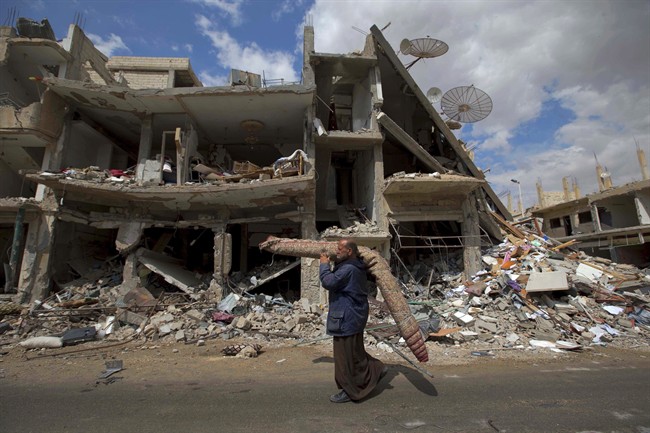COPENHAGEN – Defence Secretary Jim Mattis said the U.S. owes it to the people of Syria to take a close look at the Russian proposal to create several “safe zones” in Syria. But Mattis also said the plan poses many unanswered questions, including whether it would be effective.

Speaking to reporters travelling with him to Copenhagen, Mattis said the borders of the proposed cease-fire areas are still being worked out, although the general locations are “well understood.” And he suggested that it’s still not yet clear what impact the plan could have on the U.S.-led fight against Islamic State militants.
“It’s all in process right now,” said Mattis, who was offering some of the first extensive public U.S. comments on the agreement reached Friday by Russia, Turkey and Iran. “Who is going to be ensuring they’re safe? Who is signing up for it? Who is specifically to be kept out of them? All these details are to be worked out and we’re engaged.”
READ MORE: Turkey, Iran, Russia reach agreement on ‘de-escalation zones’ in Syria
According to activists in Syria, there already have been skirmishes on the edge of a large cease-fire zone in the northwest portion of the country. Russia, Turkey and Iran agreed to enforce a cease-fire between Syrian government and opposition forces in four locations, but Russia says map details won’t be published until early June.
The U.S. is not part of the agreement, and the Syrian government and the opposition haven’t signed on to the deal. The plan, however, does not cover areas controlled by Islamic State group militants and U.S.-backed Kurdish groups.
That leaves the U.S. and its allies free to continue the campaign to retake IS-held territory. It doesn’t, however, prevent frictions between Turkish troops and their Syrian allies from clashing or going after the U.S.-backed Syrian Kurds.
“We’ll look at the proposal, see if it can work,” said Mattis, who will attend a meeting of the anti-ISIS coalition in Copenhagen, and also travel to Lithuania and to a conference in London this week. “Will it affect the fight against ISIS? I think the international community is united in the sense of wanting to see ISIS put on its back foot.”
Mattis was circumspect when asked if the plan had any hope of ending the brutal civil war that has killed some 400,000 people and displaced nearly half of the country’s population since 2011.
“The devil is always in the details, right? So we have to look at the details, see if we can work them out, see if we think they’re going to be effective,” he said.
READ MORE: Chemical weapons watchdog ready to travel to Syria to investigate attack if safety assured
The U.S. owes it “to the situation there, the people there to at least examine it very, very carefully,” Mattis added. “All wars eventually come to an end. And we’ve been looking, for a long time, how to bring this one to an end.”
The cease-fire is an effort to allow humanitarian aid to access hard-to-reach and besieged areas in Syria, were at least 4.5 million people in need reside. The deal also calls for refugees to be allowed to return to the safe zones and services and infrastructure to be restored.
The results so far have been mixed. There was a reported drop in fighting in the four areas designated by the de-escalation agreement: the Idlib province, north Homs province, the Ghouta suburbs of Damascus and parts of Syria’s southern provinces.
The inclusion of Idlib presents a concern for the U.S., because the province near the Turkish border is held by the U.S.-backed opposition.



Comments